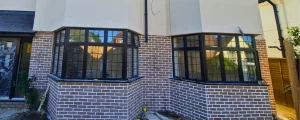Energy efficiency matters more than ever, and glazing plays a big role in how well a home holds heat. Triple glazing promises better insulation, lower bills, and quieter rooms, but it also comes at a higher cost.
For some homes, it’s a smart investment. For others, it’s money better spent elsewhere.
This guide breaks down the real pros and cons of triple glazing for UK homes, including when it’s worth the upgrade, when double glazing might be enough, and how to decide based on build type, budget, and climate.
Read on for honest insights before making your decision.
What Is Triple Glazing?
Triple glazing is a window unit made with three panes of glass instead of two. Between each pane is a spacer bar filled with an insulating gas (usually argon), creating two sealed air gaps instead of one. This extra layer helps reduce heat loss and improve energy efficiency.
Compared to standard double glazing, triple glazed units offer a lower U-value, a measure of how well a material prevents heat transfer:
- Double glazing: around 1.2–1.4 W/m²K
- Triple glazing: around 0.8–1.0 W/m²K
Lower U-values mean better insulation. That’s the main appeal of triple glazing, especially in colder parts of the UK or new builds aiming for high energy ratings.
Advantages of Triple Glazing
Triple glazing offers a few clear benefits, especially when energy performance and comfort are top priorities.
Improved Thermal Efficiency
With an extra pane of glass and two insulating gaps, triple glazing holds onto more heat. This helps reduce energy loss through windows, which is especially useful in colder regions or homes aiming for top energy ratings.
Better Soundproofing
The added glass and spacing help block out more external noise. Triple glazing can make a noticeable difference for homes near traffic, rail lines, flight paths, or busy urban streets.
Increased Security
Three panes are harder to break through than two. Most triple glazed units also come with upgraded frames and locking systems, adding another layer of protection.
Reduced Cold Spots & Condensation
Because the inner glass surface stays warmer, there’s less chance of cold patches forming near the window. That means lower risk of internal condensation collecting on the glass.
Disadvantages of Triple Glazing
Triple glazing has its benefits, but it’s not always the right fit when cost, climate, and home type are taken into account.
Higher Cost
Triple glazed units typically cost 20–30% more than double glazing. In milder parts of the UK, that added expense may not lead to noticeable energy savings.
Heavier Units
The extra layer of glass increases the overall weight. Some window frames may need reinforcement, and existing openings might require adjustments before installation.
Lower Solar Gain
More glass layers mean more solar heat is blocked. This can reduce the amount of natural warmth entering the home during colder months.
Longer Payback Time
While energy performance improves, it can take longer for the savings to balance out the higher upfront cost, particularly in homes that are already well insulated.
Is Triple Glazing Worth It in the UK?
Triple glazing can be a smart upgrade, but it depends on your home, your location, and how you want to prioritise your budget.
It’s likely worth it if:
- You’re building a new home with high energy standards like Passivhaus.
- You live in a colder part of the UK, such as Scotland or rural areas where heat loss is a bigger issue.
- Your home is near a motorway, railway, or flight path and noise reduction is a priority.
It may not be the right call if:
- You’re in a milder region where the winters aren’t as harsh.
- Your home already has modern, well-fitted double glazing that performs well.
- Your budget could do more elsewhere, like adding roof insulation or improving airtightness.
If comfort, quiet, and energy savings matter long-term, and your home is the right fit, triple glazing can be worth the spend. But if you’re upgrading in isolation, it might make more sense to focus on other areas first.
Triple Glazing vs Double Glazing: Quick Comparison Table
Still deciding between the two? Here’s a side-by-side look at how triple glazing compares to double glazing across key features:
| Feature | Double Glazing | Triple Glazing |
| Cost | Lower (££) | Higher (£££) |
| U-Value | 1.2–1.4 W/m²K | 0.8–1.0 W/m²K |
| Weight | Lighter | Heavier |
| Noise Reduction | Good | Better |
| Energy Savings | Moderate | Higher (in cold areas) |
| Solar Gain | Higher | Lower |
Use this as a guide, not a rule. The right option depends on your goals, budget, and how the rest of your home is built.
Final Thoughts
Triple glazing offers real benefits, like better insulation, less noise, and improved comfort, but it also comes at a higher price. It works well in the right setting, but is not always the most cost-effective upgrade for every home.
If you live in a colder area, are close to busy roads, or are building to high energy standards, triple glazing can make a noticeable difference. However, if your home already performs well with double glazing, the extra layer may not add as much value as you’d expect.
Focus on what makes sense for your space, climate, and priorities. The best choice is the one that improves how your home feels and works every day.
At DuraJoin, we help homeowners choose the right glazing for their space, whether that means upgrading to triple glazing or sticking with high-performance double. Every project starts with clear advice, honest pricing, and expert installation.
Thinking about new windows?
Get a free quote at durajoin.com and speak with our team about what works best for your home and budget.


